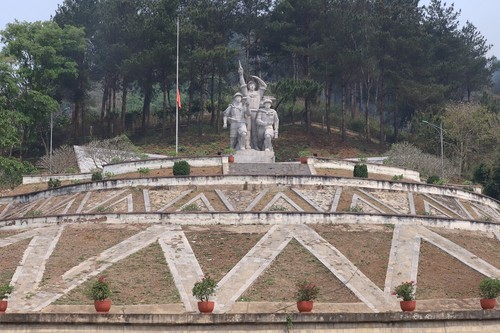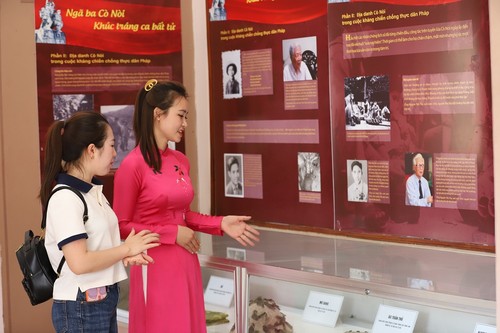 Co Noi T‑Junction Monument in Son La province (Photo: VOV) Co Noi T‑Junction Monument in Son La province (Photo: VOV) |
To supply aid to the Vietnamese army and people at the Dien Bien Phu battlefield 70 years ago, a transportation network was formed and all had to go through Co Noi T‑Junction. The French army determined this was the ‘throat’ and ‘death point’ of the Vietnamese army’s supply route of weapons and food to Dien Bien Phu. The French air force in Indochina was ordered “to turn the intersection in to a marsh” by all means possible.
The Co Noi T‑Junction became a fierce battleground itself, dubbed a ‘coordinate of fire’. Every day and night, the French military launched dozens of assaults with slow-explosive, napalm, and butterfly bombs, aiming to crush the fighting will of the Vietnamese army and people.
With determination to protect transportation artery, more than 18,000 young volunteers from all localities were mobilized to serve the campaign. About 1,000 people were on permanent duty at Co Noi T‑Junction.
 Memorabilia of former young volunteers are displayed at the Co Noi T‑Junction historical relic site. (Photo: VOV) Memorabilia of former young volunteers are displayed at the Co Noi T‑Junction historical relic site. (Photo: VOV) |
Nguyen Thi Nu, a former youth volunteer, said that from the beginning of 1954 to the end of the Dien Bien Phu campaign on May 7th the same year, there was not a single day when Co Noi T-Junction was silent with no sound of bombs and bullets. During the day they sheltered from bombing. At night they went out to repair the roads for soldiers, militia, and vehicles transporting weapons and food to pass through before dawn.
Nguyen Thi Nu said: “At that time, the French launched heavy assaults. It dropped hundreds of tons of bombs every day. The main path was destroyed. We had to open side-paths bypassing the hills. We mobilized all ordinary people to transport food and ammunition. Many people died here. We stayed united and together overcame all the difficulties to liberate Dien Bien Phu.”
Lo Van Henh of the Bomb Disposal Engineering Division at Co Noi T‑Junction recalled: “Our country called for young volunteers. I joined the volunteer force and then was assigned to the bomb disposal engineering unit. On the fiercest days of shelling, I did not eat anything for three days while I was on duty.”
To pay tribute to the profound sacrifices of the soldiers, young volunteers, and ordinary people, Son La Province built the Memorial Monument of Young Volunteer Martyrs at Co Noi Junction in 2002 and two years later it was recognized as a national relic site. In July 2021, Phase One of the project to restore and promote the value of the Co Noi T‑Junction historical relic was inaugurated. The relic is a symbol of the indomitable will of the Vietnamese people and is a ‘red address’ to teach revolutionary tradition to the younger generation.
Lo Duc Ngoc, Deputy Secretary of the Youth Union of Mai Sơn District, Son La Province, said: “Co Noi T‑Junction Monument is the ‘red address’ for Vietnamese youth to express their sincere and infinite gratitude to their predecessors. We vow to promote the noble tradition of “remembering the source of the water we drink.”
Co Noi has now become an urban area with a developed social economy interspersed between corn and sugarcane fields. Co Noi T‑Junction, a heroic symbol of the Youth Volunteer Force in the Dien Bien Phu campaign, is now the source of the motivation for today’s young generation to build a more prosperous and stronger Vietnam.